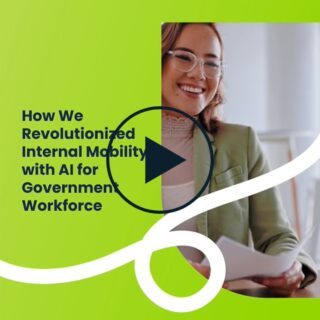Recruiting the right talent has always been a tough nut to crack for any company. And it’s becoming an even bigger challenge. Low unemployment rates, shifting workforce preferences and skills gaps make recruiting harder than ever. However, a proven solution has emerged that can expand access to talent and meet diversity goals while fueling business performance—skills-based hiring.
The goal of skills-based hiring is to match candidates not based solely on degrees or past job titles, but rather on their current, demonstrated skills aligned with role requirements. It aims to judge applicants equitably on what they can do rather than what’s on their résumé or CV. This approach opens your talent pool to a wider range of qualified candidates who may have been overlooked using traditional hiring methods.
Let’s explore what skills-based hiring entails, why more employers are embracing it and how you can get started.
What is Skills-Based Hiring?
As the name implies, skills-based hiring focuses on a candidate’s demonstrated skills and competencies rather than traditional qualifications like education, years of experience or work history. The emphasis is on relevant skills rather than “paper” credentials. For example, instead of requiring a college degree, a skills-based employer might list must-have abilities like sales, communication, analytical thinking, etc.
The hiring process itself focuses on skills fit. Interviews and talent assessments gauge how a candidate’s skillset maps to a role’s requirements. In this way, skills-based hiring removes barriers for underrepresented groups and instead gauges whether someone can actually perform well according to the role’s core skills. The goal is to judge candidates objectively and find the best match for the job.
Skills in the Workplace
So, what skills should companies actually evaluate with skills-based hiring? Skills in the workplace are made up of three key components:
- Hard Skills / Technical Skills: These are the expertise areas like programming languages (i.e., python, Java), data analysis, financial modeling, and other role-specific knowledge. While they’re crucial for many jobs, they actually make up a small fraction of the overall skills picture.
- Soft Skills: Often undervalued, soft skills in the workplace, like problem-solving, emotional intelligence, communication and critical thinking are the grease that allows hard skills to operate smoothly. For most roles outside of niche specialties, these human skills make up the vast majority of what’s needed for success.
- Values Alignment and Organizational Fit: Less about executing the day-to-day work, this is about whether someone’s personality, mindset and motivations mesh with the company culture and values. It’s about determining if the candidate embodies the attitudes and behaviors you want to see in the role and at your organization.
Benefits of a Skills-First Approach: From Engagement to Productivity
The potential benefits of skills-based hiring are plentiful. It can expand your talent pool, increase diversity by reducing bias toward pedigree over performance, improve internal mobility, and better align employees to roles they’ll thrive in.
Organizations that embrace skills-based recruiting experience:
- Increased Productivity: Hiring for skills is 5x more predictive of job performance than education and 2x more predictive than work experience.
- Top Performer Attraction: Double your chances of hiring top performers who excel in their roles and drive business success.
- Enhanced Employer Brand: Differentiate your company as a progressive, skills-first organization appealing to forward thinking professionals.
- Boosted Engagement: See a 79% increase in employee engagement when skills are recognized and utilized.
- Expanded Talent Pools: Tap into a 10x larger pool of candidates, transcending traditional sourcing methods.
- Faster Competence: Accelerate new hire ramp-up with candidates reaching competency 20% faster.
- Increased Diversity & Inclusion: Broaden diversity with a 24% increase in the talent pool of women by focusing on skills over traditional experience.
- Improved Retention: Become 98% more likely to be viewed as a prime destination for career growth thanks to a skills-based culture.
Not only does skills-based hiring boost performance and quality of hire, but it also enhances your employer brand, accelerates ramp up and improves retention.
3 Steps to Get Started with Skills-Based Hiring Today
So, how can companies start becoming more skills-based in their hiring today? The reality is that nearly one in two HR leaders admit to a lack of understanding around skills-based best practices.
The good news is that it doesn’t have to be an all-or-nothing, enterprise-wide overhaul. Here are three steps to start putting skills-based hiring in focus:
1. Understand the roles that you have.
The first step in skills-based hiring is to break down the roles you’re looking to fill into the specific skills required for success. Start with one role or a set of roles. What hard skills (technical abilities) and soft skills (personal attributes) drive top performance in each position? Collaborate with your high performers to identify these key competencies and create detailed skills profiles for each role. These profiles should be action-oriented, specific, and avoid vague or subjective requirements.
With skills profiles in hand, you can craft job descriptions that communicate the essential abilities candidates need upfront. This transparency not only attracts better-matched applicants but also sets clear expectations from the start. Consider removing degree requirements if they’re not absolutely necessary, as LinkedIn data shows that job ads listing skills tend to receive more applicants.
2. Understand people.
In a skills-based approach, you’ll evaluate candidates based on their personal skills profiles – their demonstrated hard and soft skills relevant to the role. Implement validated, data-driven assessments like coding tests, writing samples, or Excel modeling exercises to consistently measure these abilities during the hiring process. Grade candidate responses objectively against your predefined skill criteria on a scale. This data-driven approach helps minimize unconscious bias.
3. Align roles with people.
Structure your interviews to probe candidates’ proficiency in key skills through situational judgment questions and opportunities to demonstrate their competencies. Skills-based interviews, combined with detailed skills profiles for both roles and candidates, will help you make smarter, more informed talent decisions. Hire skilled individuals who match the role requirements, identify reskilling needs for existing employees, or reject candidates who don’t meet the necessary competencies.
Skills-Based Hiring & RPO: Goodbye Credentials. Hello Skills.
Skills-based hiring is still an emerging practice, but it offers companies an intriguing way to modernize talent acquisition. By focusing on what people can actually do instead of just their past experiences and credentials, you may uncover hidden gems and build higher-performing teams.
While making the shift to skills-based hiring practices takes time and effort, partnering with a recruitment process outsourcing (RPO) provider can accelerate your transition to building a future-fit workforce through this approach. An RPO partner offers the strategic guidance and operational expertise to embed skills at the core of your talent practices. They can help you carefully define and communicate role-specific skills and design fair and consistent talent assessments.
With the support of an RPO partner like PeopleScout, you can embed fairness and future-readiness into your talent strategies, building a more skilled, capable workforce prepared to drive your organization’s success.




